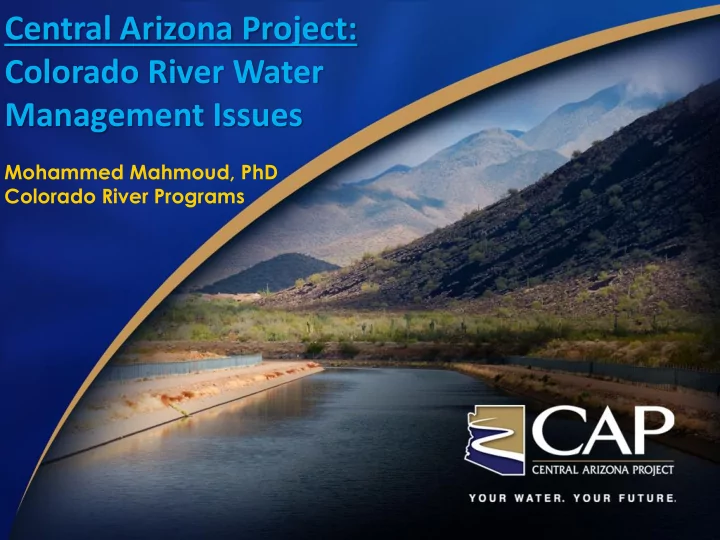

Central Arizona Project: Colorado River Water Management Issues Mohammed Mahmoud, PhD Colorado River Programs
Physical Characteristics • 10 major reservoirs • Lake Powell and Lake Mead store 4 times the • 92% of the Colorado River Basin's Basin's historical mean mean annual flow occurs above annual flow • Lees Ferry (1906-2007) Serves 40 million people in US/Mexico and 4 million acres of • Mean annual flow is close to 15.0 irrigation MAF, ranging from 5.6 MAF to • Power generation ~ 25.2 MAF 10,000 Gw-hrs/yr • Upper Colorado and Green River are the most important tributaries: 75% of annual flow. • Lower Basin tributaries (Virgin/Muddy, Paria, Little Colorado, Bill Williams, Gila) contribute less than 10% of average flow
Significant Reservoirs Powell: Upper Basin Curtailment Mead: Lower Basin Supply 1963 Lake Powell (Glen Canyon Dam) 1936 Lake Mead (Hoover Dam)
2007 Interim Guidelines: Shortage Sharing • Arizona and Nevada share Lower Basin shortages under the 2007 Guidelines (through 2026) • Mexico voluntarily agreed in Minute 319 to accept reductions in its deliveries at the same elevations Lake Mead Arizona Nevada Mexico Elevation Reduction Reduction Reduction 1075’ 320,000 AF 13,000 AF 50,000 AF 1050’ 400,000 AF 17,000 AF 70,000 AF 1025’ 480,000 AF 20,000 AF 125,000 AF • No reductions to California under 2007 Guidelines
What Influences Lower Basin Shortage? 1. Colorado River Reservoir Operations 2. Uses in the Upper Basin 3. Colorado River Basin Hydrology 4. Lower Basin Uses and the Structural Deficit
What drives basin hydrology?
Precipitation and Snowpack 137% of Median 200-300% of Average
Lower Basin Water Allocation Lower Basin (AZ, CA, NV, Mexico + Losses) 9.6 MAF Lake Mead evaporation losses 0.6 MAF Average Inflow 9.0 MAF Structural Deficit - 1.2 MAF Given basic apportionments in the Lower Basin, the allotment in Mexico, and an 8.23 MAF from Lake Powell, Lake Mead declines about 12 feet each year.
Lake Mead Elevation Lower Basin Structural Deficit
Risk to All Colorado River Users Without system intervention or hydrologic relief, Lake Mead could potentially fall to dangerously low elevations… If Lake Mead falls below elevation 1000’: • Impacts quality of water that SNWA withdraws (new intake) • Less than 4.5 MAF left in storage in Lake Mead (approx. equal to CA’s allocation) BAD THINGS CAN HAPPEN ! • Reduced power generation and efficiency at Hoover Dam, potential cavitation or vibration damage • Secretary can take additional measures (below 1025’) • Higher risk of dropping towards dead pool (895’) and not recovering above shortage levels
Current Status: Lower Basin Shortage Lake Mead is at elevation 1090 feet = 42% capacity • 2019 – No Shortage • 2020 – 69% probability • 2021 – 82% probability • 2022 – 81% probability Based on Bureau of Reclamation projections from January 2019
Augmentation and Storage • Water Banking • CAP and the Arizona Water Banking Authority (AWBA) have stored water underground for future recovery during shortages (Just over 4 MAF – over twice CAP’s annual diversions from the Colorado River) • Weather Modification • CAP partially co-funds with Lower Basin partners cloud seeding projects in Wyoming, Colorado, and Utah to augment Colorado River snowpack
Drought Response Actions (Pilot MOU) • Voluntary development of water in Lake Mead • Creation of Protection Volumes in 2014-2019 by CAP, USBR, SNWA, MWD (740 KAF) CAP’s Cooperative Programs CAP Municipal Customers • Received local supply in lieu of CAP delivery (CAP credits with SRP) • No cost to CAP CAP Agricultural customers in Central Arizona • Ag Forbearance for reduced rate/charge • Flexibility in using other water supply sources Yuma Mesa Irrigation and Drainage District • Pilot program with CAGRD • Compensation for fallowing of irrigation acres
Pilot System Conservation Program • System conservation programs effective in partially mitigating drought impacts (total conservation target of over 100 KAF) • Provided opportunities to test new and innovative conservation approaches • Program considered conservation in different water sectors: agricultural, municipal, industrial, etc. • Water users compensated for voluntary reductions in water use • Funding provided by CAP, USBR, SNWA, MWD, Denver Water • Funding supported Upper and Lower Basin projects in all Basin States 16
Lower Basin Drought Contingency Plan (LBDCP) • New proposed reductions by each Lower Basin State (Arizona, Nevada, California) • Earlier and larger reductions by Arizona and Nevada • Water Conservation volume contributions by U.S. Bureau of Reclamation • Reductions by California at lower Lake Mead elevations • LBDCP overlays the 2007 Shortage Sharing Guidelines (additive process) • Protects Lake Mead from extreme declines in elevation • Contingent on LBDCP approval, Mexico will contribute additional voluntary reductions 17
Any Questions ?
Drought Contin ingency Pla lan (DCP): Lake Mead Elevation AZ Reduction NV Reduction CA Reduction USBR Total (AF) (Feet) (AF) (AF) (AF) Reduction (AF) 1,090 - 1,075 192,000 8,000 0 100,000 300,000 1,075 - 1,050 192,000 8,000 0 100,000 300,000 1,050 - 1,045 192,000 8,000 0 100,000 300,000 1,045 - 1,040 240,000 10,000 200,000 100,000 550,000 1,040 - 1,035 240,000 10,000 250,000 100,000 600,000 1,035 - 1,030 240,000 10,000 300,000 100,000 650,000 1,030 - 1,025 240,000 10,000 350,000 100,000 700,000 < 1,025 240,000 10,000 350,000 100,000 700,000
Recommend
More recommend